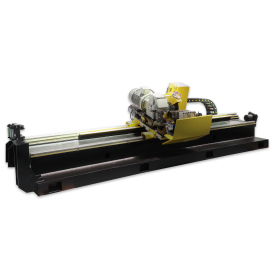[CNC Flying Saw Machine]Transforming Precision Cutting: The Advantages and Applications of CNC Flying Saw Machines in Modern Manufacturing
News 2024-10-9
****In the modern manufacturing landscape, precision and efficiency are crucial. Among the innovative technologies that have significantly advanced the industry is the CNC Flying Saw Machine. With its unique design and operational capabilities, the CNC Flying Saw Machine has become an indispensable tool in various sectors, from metalworking to construction. In this article, we will explore the key features, benefits, and applications of the CNC Flying Saw Machine, showcasing how it is transforming the way materials are cut and shaped.
What is a CNC Flying Saw Machine?

Transforming Precision Cutting: The Advantages and Applications of CNC Flying Saw Machines in Modern Manufacturing
Key Features of CNC Flying Saw Machines
1. **Precision Cutting**: One of the most significant advantages of CNC Flying Saw Machines is their ability to deliver precise cuts consistently. The CNC system allows for meticulous control over the cut length, angle, and depth, ensuring that each piece meets exact specifications.
2. **Increased Speed**: The design of the flying saw enables it to make swift cuts, resulting in reduced cycle times. This speed not only enhances overall production efficiency but also decreases the processing costs per unit. When dealing with high volumes of materials, this efficiency can significantly impact the bottom line.
3. **Versatility**: CNC Flying Saw Machines can cut various materials, including steel, aluminum, and plastic. Their versatility makes them suitable for multiple industries—from automotive to construction—making them an essential investment for manufacturers looking to diversify their capabilities.
4. **Reduced Waste**: The precision of CNC Flying Saw Machines reduces material waste due to fewer errors during the cutting process. By minimizing scrap, manufacturers can further cut costs and improve sustainability, drawing increasingly positive attention in an eco-conscious world.
5. **Automation and Control**: With advanced CNC programming, operators can easily set up the machine for different cutting tasks without manual intervention. This automation reduces the potential for human error and streamlines the workflow, leading to higher productivity levels.
Applications of CNC Flying Saw Machines
CNC Flying Saw Machines have a wide array of applications across different industries:
1. **Metal Fabrication**: In metalworking, Flying Saw Machines excel at cutting steel beams, pipes, and sheets. Their precision ensures that even complicated shapes can be achieved, catering to various fabrication needs.

Transforming Precision Cutting: The Advantages and Applications of CNC Flying Saw Machines in Modern Manufacturing

Transforming Precision Cutting: The Advantages and Applications of CNC Flying Saw Machines in Modern Manufacturing
3. **Manufacturing of Pipes and Tubes**: CNC Flying Saw Machines are extensively used in the production of pipes and tubes, enabling manufacturers to achieve clean cuts and maintain dimensional accuracy crucial for pipe integrity in fluid transfer applications.
4. **Automotive Industry**: The automotive sector relies on Flying Saw Machines for cutting raw materials and preparing parts for assembly. Their unrivaled speed and precision allow manufacturers to keep pace with production demands in a competitive market.
Conclusion
The CNC Flying Saw Machine stands out as a cornerstone of modern manufacturing, offering unique benefits that enhance productivity, quality, and efficiency. Its capabilities go beyond simple cutting, integrating sophisticated technology that shapes the future of industrial operations. By understanding the advantages and applications of CNC Flying Saw Machines, manufacturers can make informed decisions on investing in this technology, positioning themselves advantageously in an increasingly competitive environment. In a world where every second and every cut counts, the CNC Flying Saw Machine proves itself to be a critical asset, driving continuous improvement and innovation in the manufacturing industry.
